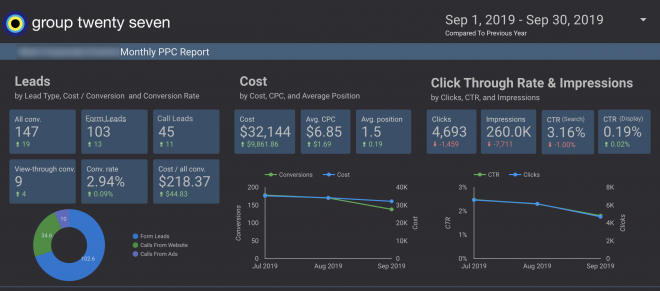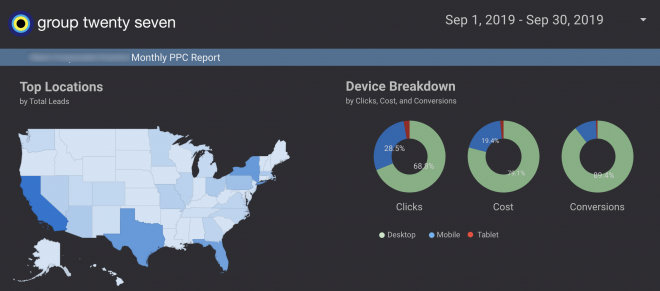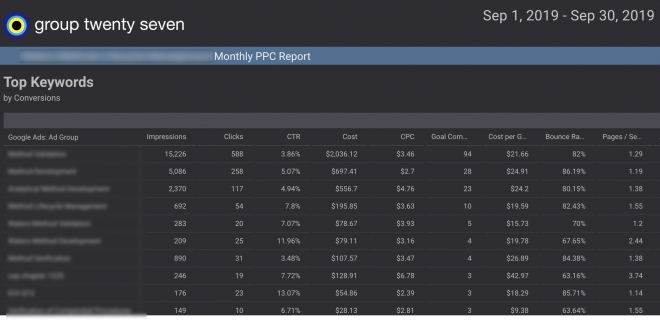If you weren’t able to use December to prepare for PPC in 2002, it’s not too late!
You still have time to regroup and look ahead.
And it’s important to do so — because the strategies you put into place now can continue to pay dividends throughout 2020.
If you’re not sure where to start, here are four suggestions on where to put your efforts.

1. Data Studio
Google’s Data Studio is a way to directly connect your data sources to your reporting.
It was rolled out in 2016. Since then, it’s only gotten better.
Data Studio is a must for marketers.
If you’re still reporting to your clients and/or executives with Excel, this one’s for you!
Not only do these reports look great, but they will also save you a ton of time.
You can customize reports to the interests and preferences of your clients and executives. And when you need to update your data, you can do it in seconds simply by changing the date range.
And because these reports on automated, you also reduce the risk of data entry errors.
Let me give you a couple of examples of how we’ve been using it.
Here, we used Data Studio to highlight leads, costs, CTRs, and impressions:

Here, we used Data Studio to report on locations and devices:

And here we used Data Studio to report on keywords:

In addition to pulling data from Google Ads, you can also pull metrics from Google Analytics.
You can combine those two sources of data in Data Studio to make one ultra-rich report.
We also use Data Studio as a data dashboard. It’s a quick way for us to check metrics without having to drill down into every account to find what we need.
Fortunately, Data Studio isn’t that complicated to set up. Once you do, you can use it over and over again.
For a quick primer, check out this article on Social Media Examiner. You can also take a course on Data Studio through the Google Analytics Academy.
2. Google Ads Scripts
Google Ads scripts have been around for a while. They’re a way to automate common procedures or interact with external data by using JavaScript in a browser-based IDE. (The IDE helps with syntax, highlighting, autocomplete and previewing.)
If the above paragraph made your eyes glaze over, don’t despair.
Many JavaScript-savvy people have written Google Ads scripts that you can use — so you don’t need to write them yourself.
However, some these scripts are more useful than others.
Some scripts to consider are those that check for broken URLs, track quality scores, and identify negative keywords that are blocking ads from previously converting search queries.
Budget tracking scripts also look interesting.
If you’re trying scripts for the first time, start with something easy, such as a “pause or delete keywords with zero impressions” script.
This is a great way to trim excess fat from your accounts on a monthly or quarterly basis and get more comfortable with scripts in general.
Again, not all of these scripts will be useful to you, but it’s worth having a look to see what’s out there. You might find an easy solution to a long-standing challenge.
3. Revisit Audience Opportunities
Google recently rolled out two new audience targeting options:
- Affinity audiences.
- In-market seasonal event segments.
Affinity audiences have been available in Display and Video campaigns for years, but now Google is bringing them to Search and YouTube campaigns. (As you may recall, affinity audiences allow you to reach consumers based on a holistic picture of their lifestyle, passion and habits.)
Google brought in-market audiences to Search in 2017. In-market audiences are customers who are actively researching and considering the purchase of services or products similar to yours.
But now, Google is adding seasonal segments, such as Black Friday and Christmas, to Search and YouTube.
If you haven’t ventured into these targeting options yet, this is the perfect time to dip your toe in. Add them to your accounts in observation mode and see how they perform.
If you start collecting data now, you’ll be ready to optimize in early 2020.
4. New Lead Form Extensions
We were excited to learn that Google Ads is testing a new type of extension in Search.
New lead form extensions allow you to add a lead form to your ads. You can deliver your call-to-action in the form of a web link or direct download, and you can customize your ad with your own brand image.
Currently, the amount of data you can collect through the form is quite limited. Right now, your only options are name, email, phone number and postal/zip code.
When a lead form is opened, it counts as a click. When the form is completed and submitted, it counts as a conversion.
You can download the leads you get from your form as a CSV file or you can bring them into your CRM system in real-time with Webhook.
This extension is still in the beta testing phase.
Also important to note: According to a Google help page, some sensitive verticals are not eligible for this type of extension.
Get a Head Start on 2020
While it’s tempting to slow down at this time of year, it’s actually a great time to get a head start on the year to come.
If you put the work in now, you’ll reap the benefits throughout 2020.
And that’s time well spent.
This article was originally published in Search Engine Journal.






